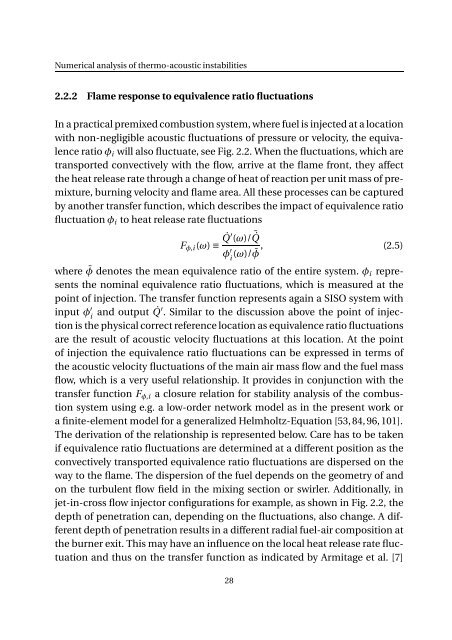Impact of fuel supply impedance and fuel staging on gas turbine ...
Impact of fuel supply impedance and fuel staging on gas turbine ...
Impact of fuel supply impedance and fuel staging on gas turbine ...
Create successful ePaper yourself
Turn your PDF publications into a flip-book with our unique Google optimized e-Paper software.
Numerical analysis <str<strong>on</strong>g>of</str<strong>on</strong>g> thermo-acoustic instabilities<br />
2.2.2 Flame resp<strong>on</strong>se to equivalence ratio fluctuati<strong>on</strong>s<br />
In a practical premixed combusti<strong>on</strong> system, where <str<strong>on</strong>g>fuel</str<strong>on</strong>g> is injected at a locati<strong>on</strong><br />
with n<strong>on</strong>-negligible acoustic fluctuati<strong>on</strong>s <str<strong>on</strong>g>of</str<strong>on</strong>g> pressure or velocity, the equivalence<br />
ratio φ i will also fluctuate, see Fig. 2.2. When the fluctuati<strong>on</strong>s, which are<br />
transported c<strong>on</strong>vectively with the flow, arrive at the flame fr<strong>on</strong>t, they affect<br />
the heat release rate through a change <str<strong>on</strong>g>of</str<strong>on</strong>g> heat <str<strong>on</strong>g>of</str<strong>on</strong>g> reacti<strong>on</strong> per unit mass <str<strong>on</strong>g>of</str<strong>on</strong>g> premixture,<br />
burning velocity <str<strong>on</strong>g>and</str<strong>on</strong>g> flame area. All these processes can be captured<br />
by another transfer functi<strong>on</strong>, which describes the impact <str<strong>on</strong>g>of</str<strong>on</strong>g> equivalence ratio<br />
fluctuati<strong>on</strong> φ i to heat release rate fluctuati<strong>on</strong>s<br />
F φ,i (ω)≡ ˙Q ′ (ω)/ ¯˙Q<br />
φ ′ i (ω)/ ¯φ , (2.5)<br />
where ¯φ denotes the mean equivalence ratio <str<strong>on</strong>g>of</str<strong>on</strong>g> the entire system. φ i represents<br />
the nominal equivalence ratio fluctuati<strong>on</strong>s, which is measured at the<br />
point <str<strong>on</strong>g>of</str<strong>on</strong>g> injecti<strong>on</strong>. The transfer functi<strong>on</strong> represents again a SISO system with<br />
input φ ′ i<br />
<str<strong>on</strong>g>and</str<strong>on</strong>g> output ˙Q ′ . Similar to the discussi<strong>on</strong> above the point <str<strong>on</strong>g>of</str<strong>on</strong>g> injecti<strong>on</strong><br />
is the physical correct reference locati<strong>on</strong> as equivalence ratio fluctuati<strong>on</strong>s<br />
are the result <str<strong>on</strong>g>of</str<strong>on</strong>g> acoustic velocity fluctuati<strong>on</strong>s at this locati<strong>on</strong>. At the point<br />
<str<strong>on</strong>g>of</str<strong>on</strong>g> injecti<strong>on</strong> the equivalence ratio fluctuati<strong>on</strong>s can be expressed in terms <str<strong>on</strong>g>of</str<strong>on</strong>g><br />
the acoustic velocity fluctuati<strong>on</strong>s <str<strong>on</strong>g>of</str<strong>on</strong>g> the main air mass flow <str<strong>on</strong>g>and</str<strong>on</strong>g> the <str<strong>on</strong>g>fuel</str<strong>on</strong>g> mass<br />
flow, which is a very useful relati<strong>on</strong>ship. It provides in c<strong>on</strong>juncti<strong>on</strong> with the<br />
transfer functi<strong>on</strong> F φ,i a closure relati<strong>on</strong> for stability analysis <str<strong>on</strong>g>of</str<strong>on</strong>g> the combusti<strong>on</strong><br />
system using e.g. a low-order network model as in the present work or<br />
a finite-element model for a generalized Helmholtz-Equati<strong>on</strong> [53, 84, 96, 101].<br />
The derivati<strong>on</strong> <str<strong>on</strong>g>of</str<strong>on</strong>g> the relati<strong>on</strong>ship is represented below. Care has to be taken<br />
if equivalence ratio fluctuati<strong>on</strong>s are determined at a different positi<strong>on</strong> as the<br />
c<strong>on</strong>vectively transported equivalence ratio fluctuati<strong>on</strong>s are dispersed <strong>on</strong> the<br />
way to the flame. The dispersi<strong>on</strong> <str<strong>on</strong>g>of</str<strong>on</strong>g> the <str<strong>on</strong>g>fuel</str<strong>on</strong>g> depends <strong>on</strong> the geometry <str<strong>on</strong>g>of</str<strong>on</strong>g> <str<strong>on</strong>g>and</str<strong>on</strong>g><br />
<strong>on</strong> the turbulent flow field in the mixing secti<strong>on</strong> or swirler. Additi<strong>on</strong>ally, in<br />
jet-in-cross flow injector c<strong>on</strong>figurati<strong>on</strong>s for example, as shown in Fig. 2.2, the<br />
depth <str<strong>on</strong>g>of</str<strong>on</strong>g> penetrati<strong>on</strong> can, depending <strong>on</strong> the fluctuati<strong>on</strong>s, also change. A different<br />
depth <str<strong>on</strong>g>of</str<strong>on</strong>g> penetrati<strong>on</strong> results in a different radial <str<strong>on</strong>g>fuel</str<strong>on</strong>g>-air compositi<strong>on</strong> at<br />
the burner exit. This may have an influence <strong>on</strong> the local heat release rate fluctuati<strong>on</strong><br />
<str<strong>on</strong>g>and</str<strong>on</strong>g> thus <strong>on</strong> the transfer functi<strong>on</strong> as indicated by Armitage et al. [7]<br />
28
















